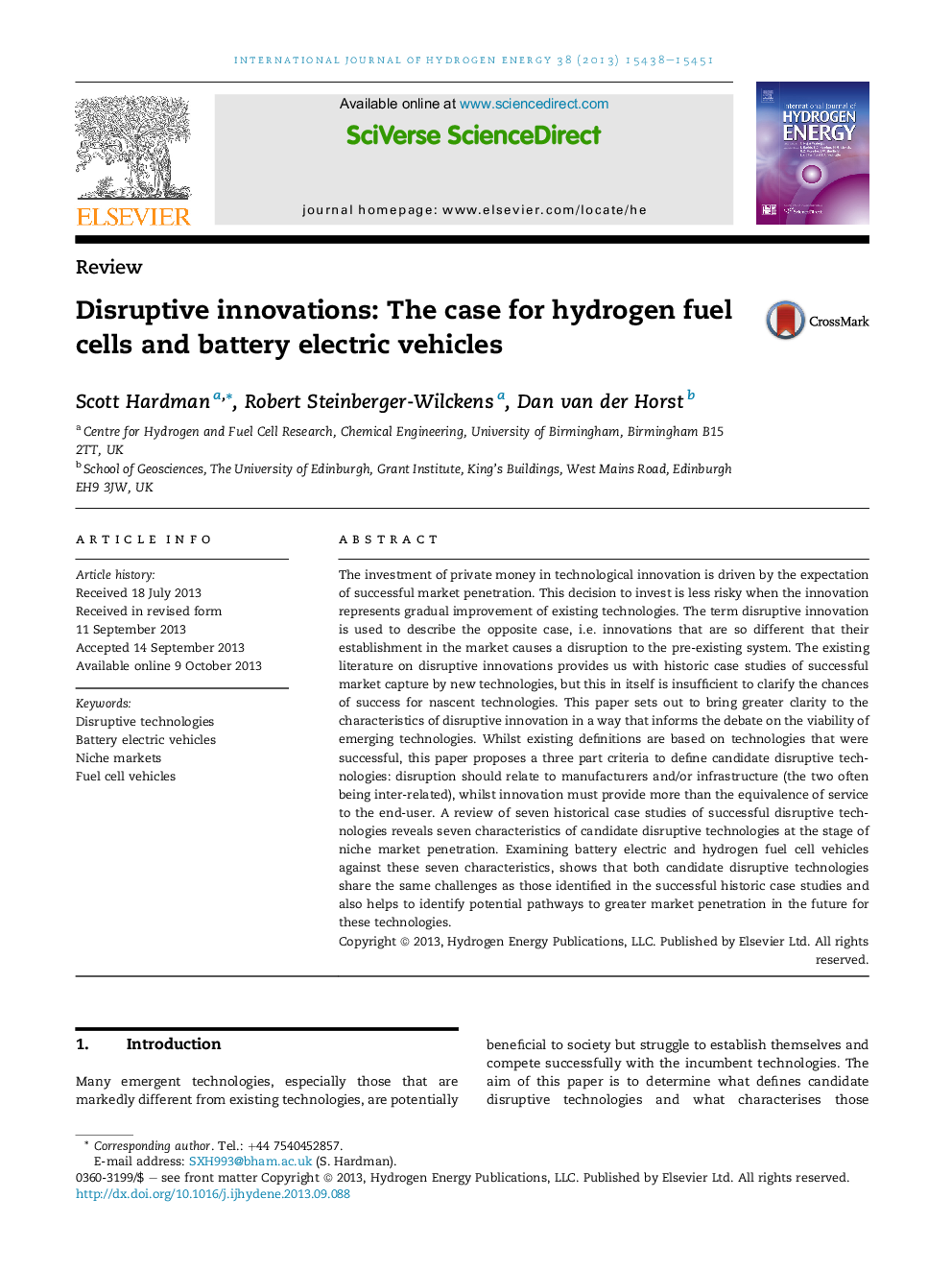| کد مقاله | کد نشریه | سال انتشار | مقاله انگلیسی | نسخه تمام متن |
|---|---|---|---|---|
| 7721301 | 1497510 | 2013 | 14 صفحه PDF | دانلود رایگان |
عنوان انگلیسی مقاله ISI
Disruptive innovations: The case for hydrogen fuel cells and battery electric vehicles
ترجمه فارسی عنوان
نوآوری های مزاحم: مورد برای سلول های سوخت هیدروژن و خودروهای الکتریکی باتری
دانلود مقاله + سفارش ترجمه
دانلود مقاله ISI انگلیسی
رایگان برای ایرانیان
کلمات کلیدی
تکنولوژی های خرابکارانه، وسایل الکتریکی باتری، بازارهای طاقچه ای، وسایل نقلیه سوخت
ترجمه چکیده
سرمایه گذاری پول خصوصی در نوآوری های تکنولوژیکی به وسیله انتظارات نفوذ بازار موفقیت آمیز است. این تصمیم برای سرمایه گذاری کمتر خطرناک است وقتی که نوآوری نشان دهنده بهبود تدریجی تکنولوژی های موجود است. نوآوری ناخوشایند به منظور توصیف مورد مخالف، یعنی نوآوری هایی که بسیار متفاوت است، ایجاد آنها در بازار، باعث اختلال در سیستم پیشین شده است. ادبیات موجود در مورد نوآوری های مخرب، ما را با مطالعات موردی تاریخی از ضرب و شتم موفقیت آمیز بازار از طریق تکنولوژی های جدید، را فراهم می کند، اما این به خودی خود برای نشان دادن شانس موفقیت برای فن آوری های نوظهور کافی نیست. این مقاله با هدف وضوح بیشتری در خصوص ویژگی های نوآوری مخرب به گونه ای ارائه می دهد که به بحث در مورد قابلیت حیات فن آوری های در حال ظهور اطلاع می دهد. در حالی که تعاریف موجود مبتنی بر فن آوری هایی هستند که موفق بوده اند، در این مقاله معیارهای سه گانه برای تعریف فن آوری های نامطلوب نامزد می شود: اختلال باید مربوط به تولید کنندگان و / یا زیرساخت ها باشد (این دو اغلب در ارتباط هستند)، در حالیکه نوآوری باید بیش از همگرایی سرویس به کاربر نهایی. بررسی هفت مورد مطالعات موردی در مورد تکنولوژی های خرابکار موفق نشان دهنده هفت ویژگی تکنولوژی های نامطلوب نامطلوب در مرحله نفوذ بازار طاقچه است. بررسی باتری های الکتریکی و سوخت های هیدروژن سوخت بر علیه این هفت ویژگی، نشان می دهد که هر دو تکنولوژی های نامطلوب داوطلب، همان چالش هایی را که در مطالعات موردی در مورد تاریخچه موفقیت آمیز دارند، به اشتراک می گذارند و همچنین به شناسایی راه های بالقوه برای نفوذ بیشتر بازار در آینده برای این فن آوری ها کمک می کند.
موضوعات مرتبط
مهندسی و علوم پایه
شیمی
الکتروشیمی
چکیده انگلیسی
The investment of private money in technological innovation is driven by the expectation of successful market penetration. This decision to invest is less risky when the innovation represents gradual improvement of existing technologies. The term disruptive innovation is used to describe the opposite case, i.e. innovations that are so different that their establishment in the market causes a disruption to the pre-existing system. The existing literature on disruptive innovations provides us with historic case studies of successful market capture by new technologies, but this in itself is insufficient to clarify the chances of success for nascent technologies. This paper sets out to bring greater clarity to the characteristics of disruptive innovation in a way that informs the debate on the viability of emerging technologies. Whilst existing definitions are based on technologies that were successful, this paper proposes a three part criteria to define candidate disruptive technologies: disruption should relate to manufacturers and/or infrastructure (the two often being inter-related), whilst innovation must provide more than the equivalence of service to the end-user. A review of seven historical case studies of successful disruptive technologies reveals seven characteristics of candidate disruptive technologies at the stage of niche market penetration. Examining battery electric and hydrogen fuel cell vehicles against these seven characteristics, shows that both candidate disruptive technologies share the same challenges as those identified in the successful historic case studies and also helps to identify potential pathways to greater market penetration in the future for these technologies.
ناشر
Database: Elsevier - ScienceDirect (ساینس دایرکت)
Journal: International Journal of Hydrogen Energy - Volume 38, Issue 35, 22 November 2013, Pages 15438-15451
Journal: International Journal of Hydrogen Energy - Volume 38, Issue 35, 22 November 2013, Pages 15438-15451
نویسندگان
Scott Hardman, Robert Steinberger-Wilckens, Dan van der Horst,
